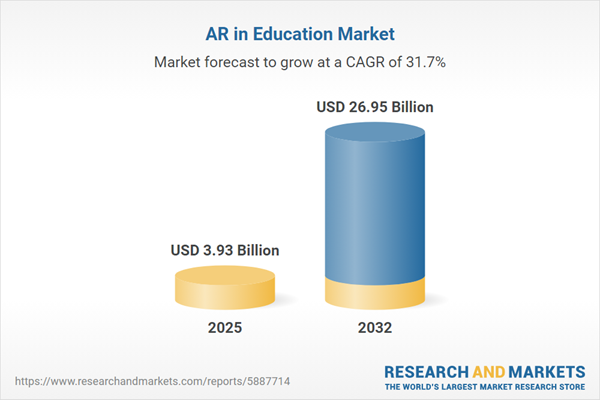Speak directly to the analyst to clarify any post sales queries you may have.
Senior education leaders are prioritizing the adoption of augmented reality (AR) solutions as a core strategy for enriching learning outcomes and increasing organizational efficiency. The AR in Education Market is becoming an essential component in driving academic transformation, empowering institutions to stay ahead of evolving educational trends and strategic demands.
Market Snapshot: AR in Education Market Size & Growth
The AR in Education Market expanded from USD 2.98 billion in 2024 to USD 3.93 billion in 2025, recording a compound annual growth rate (CAGR) of 31.67%. Projections point to a market size of USD 26.95 billion by 2032, reflecting robust demand for immersive and interactive technology solutions. Advancements in AR capabilities are enabling providers to address the needs of diverse educational environments, facilitating pedagogical innovation, enabling broader digital access, and reinforcing technology leadership among institutions seeking a competitive edge.
Scope & Segmentation Across AR in Education
The scope of the AR in Education Market covers a wide array of technological innovations and business models, giving executive teams several avenues to align technology with institutional strategy. This segmentation ensures that decision-makers can tailor solutions according to their infrastructure, user needs, and regional conditions:
- Component: Hardware such as head mounted displays and smart glasses empower experiential learning. Software includes AR content creation tools, digital assessment platforms, and visualization solutions for flexible curricula. Services comprise consulting, system integration, maintenance, and support to maximize uptime and long-term system value.
- Deployment Mode: Institutions can select from cloud-based deployments (both public and private), on-premise platforms, or direct server models, offering flexibility to match IT governance and operational requirements.
- Application: Common use cases range from enhancing classroom engagement and supporting digital assessments to promoting language learning, advancing STEM instruction, and enabling virtual laboratories for practical skill-building.
- End User: The market addresses both higher education—including public and private universities—and K-12 schools across public and private sectors, supporting a spectrum of learning environments and administrative structures.
- Regional Coverage: Distinct adoption patterns are observed across the Americas, Europe, Middle East & Africa, and Asia-Pacific. Regional investment climates, regulatory frameworks, and institutional readiness drive localized AR strategies and procurement priorities.
- Key Companies Profiled: Major industry players such as Microsoft Corporation, Google LLC, Apple Inc., Meta Platforms, PTC Inc., zSpace Inc., Magic Leap Inc., EON Reality Inc., Zappar Limited, and 3D4Medical Ltd. shape benchmarks for digital transformation with their evolving solution portfolios.
Key Takeaways for Senior Decision-Makers
- Immersive AR applications can significantly boost student participation by enabling interactive, hands-on experiences and supporting personalized learning pathways.
- Engagement in strategic partnerships among AR technology and content providers can increase flexibility in solution deployment and assist in diversifying risk.
- Adopting cloud-native and hybrid AR models offers scalable infrastructure, allows for frequent technology updates, and centralizes data management for ease of use by academic and IT teams.
- Availability of modular AR content tools gives faculty greater autonomy in tailoring instructional resources, minimizing reliance on technical specialists.
- Procurement approaches often hinge on institutional focus: private colleges typically seek bespoke, innovative deployments, while public schools emphasize sustainability and cost management.
- Integrated analytics capabilities in AR platforms help institutions measure learning outcomes, facilitate funding proposals, and align progress with broader educational objectives.
Tariff Impact on Adoption and Cost Structures
Recent changes in tariff policies for electronics have led AR hardware providers to shift logistics strategies, pursue nearshoring, and diversify their supply bases, impacting pricing structures for educational buyers. Cloud-based AR applications can offset direct hardware expenses by leveraging managed services, but they introduce considerations around regulatory compliance, especially in relation to data privacy and residency. Increasingly, institutions are adopting blended approaches such as device leasing paired with subscription-based services to optimize operational access and mitigate exposure to supply chain risks and price fluctuations.
Methodology & Data Sources
This report draws on comprehensive interviews with technology and education sector leaders, primary B2B market research, authoritative academic publications, and tailored proprietary analytics. Findings are validated through industry expert consultation, ensuring accuracy and practical relevance for executive stakeholders.
Why This Report Matters
- Presents actionable AR in Education Market segmentation with insights to guide planning, budgeting decisions, and technology purchasing for educational leadership teams.
- Explains the implications of regulatory and tariff changes, supporting procurement teams in designing robust acquisition strategies for dynamic market conditions.
- Identifies opportunities for meaningful collaboration among technology vendors, educational organizations, and policymakers, advancing innovative practices in teaching and digital integration.
Conclusion
Ongoing advancements in AR technology are reshaping educational delivery and institutional operations. Leaders equipped with strategic AR market intelligence will be better prepared to guide their organizations through continued digital transformation and emerging educational challenges.
Additional Product Information:
- Purchase of this report includes 1 year online access with quarterly updates.
- This report can be updated on request. Please contact our Customer Experience team using the Ask a Question widget on our website.
Table of Contents
3. Executive Summary
4. Market Overview
7. Cumulative Impact of Artificial Intelligence 2025
Samples

LOADING...
Companies Mentioned
The key companies profiled in this AR in Education market report include:- Microsoft Corporation
- Google LLC
- Apple Inc.
- Meta Platforms, Inc.
- PTC, Inc.
- zSpace, Inc.
- Magic Leap, Inc.
- EON Reality, Inc.
- Zappar Limited
- 3D4Medical, Ltd.
Table Information
| Report Attribute | Details |
|---|---|
| No. of Pages | 182 |
| Published | October 2025 |
| Forecast Period | 2025 - 2032 |
| Estimated Market Value ( USD | $ 3.93 Billion |
| Forecasted Market Value ( USD | $ 26.95 Billion |
| Compound Annual Growth Rate | 31.6% |
| Regions Covered | Global |
| No. of Companies Mentioned | 11 |









